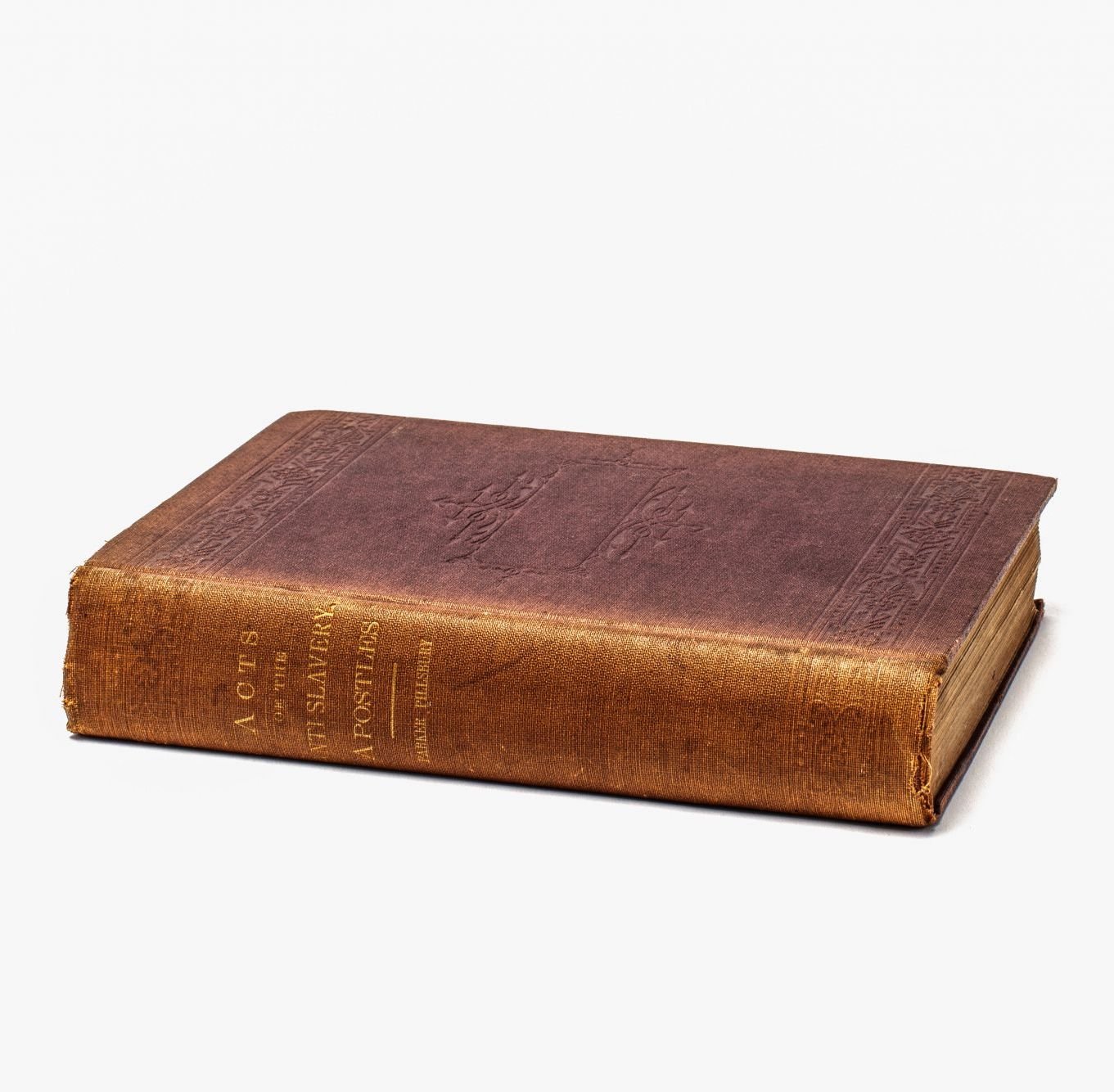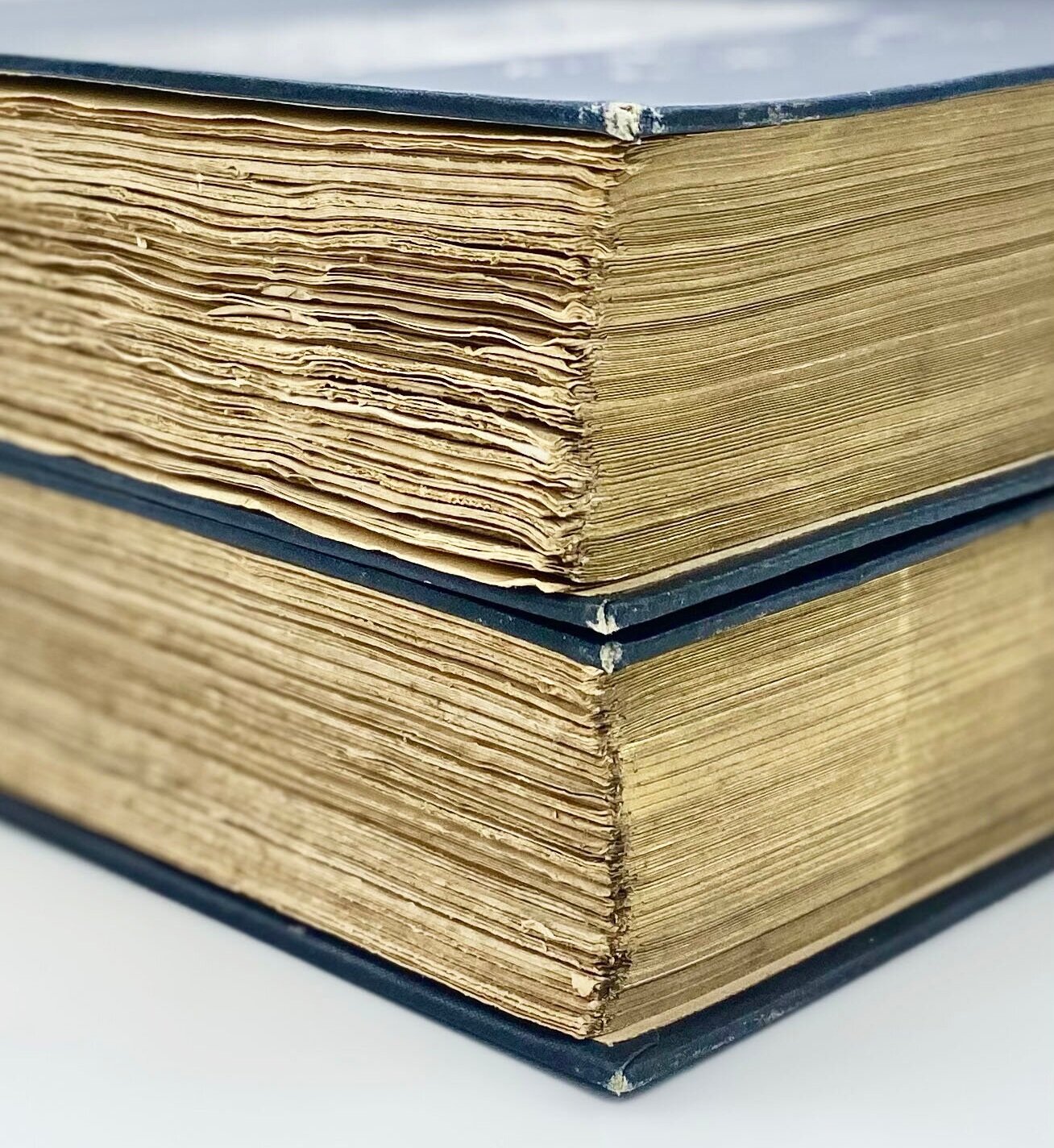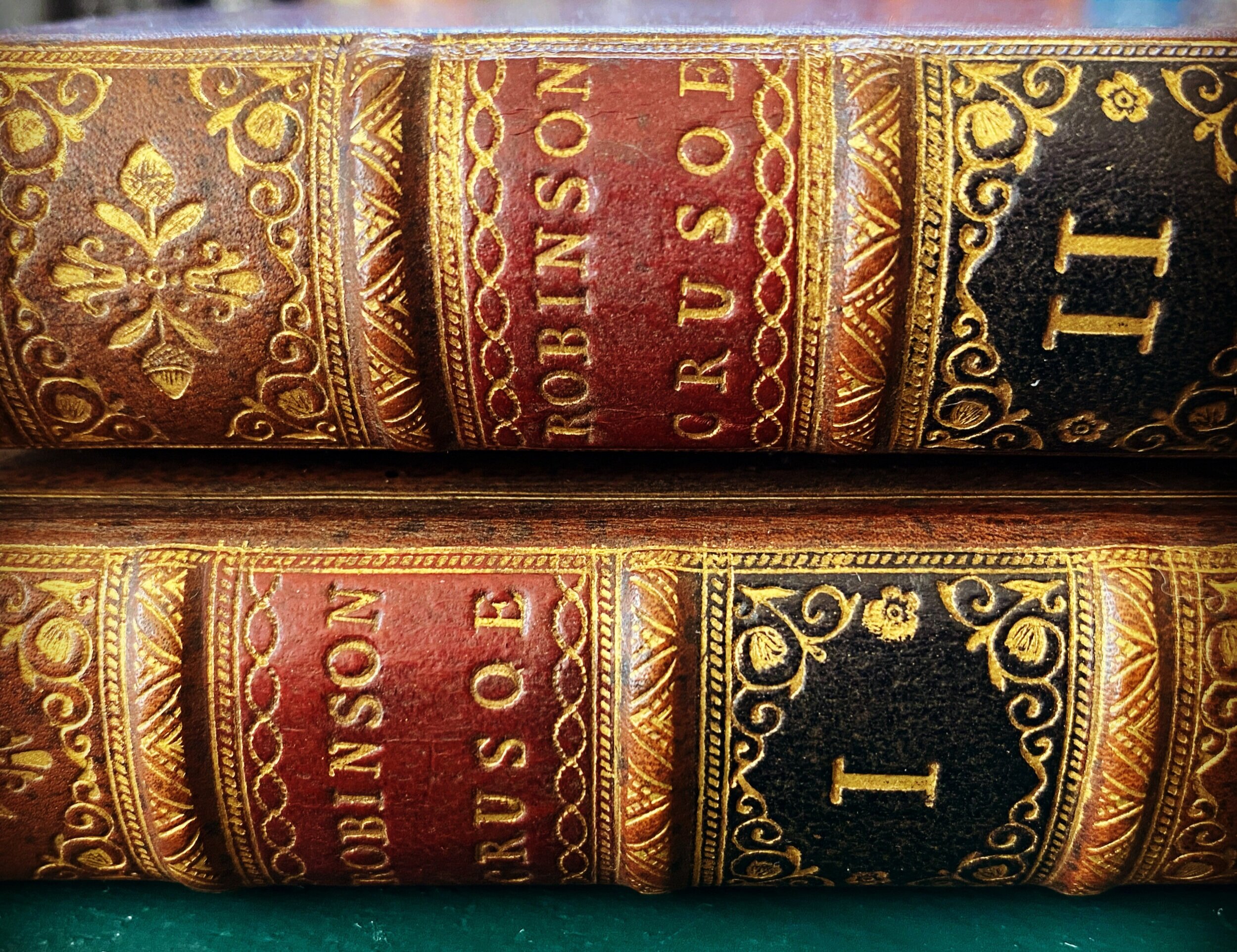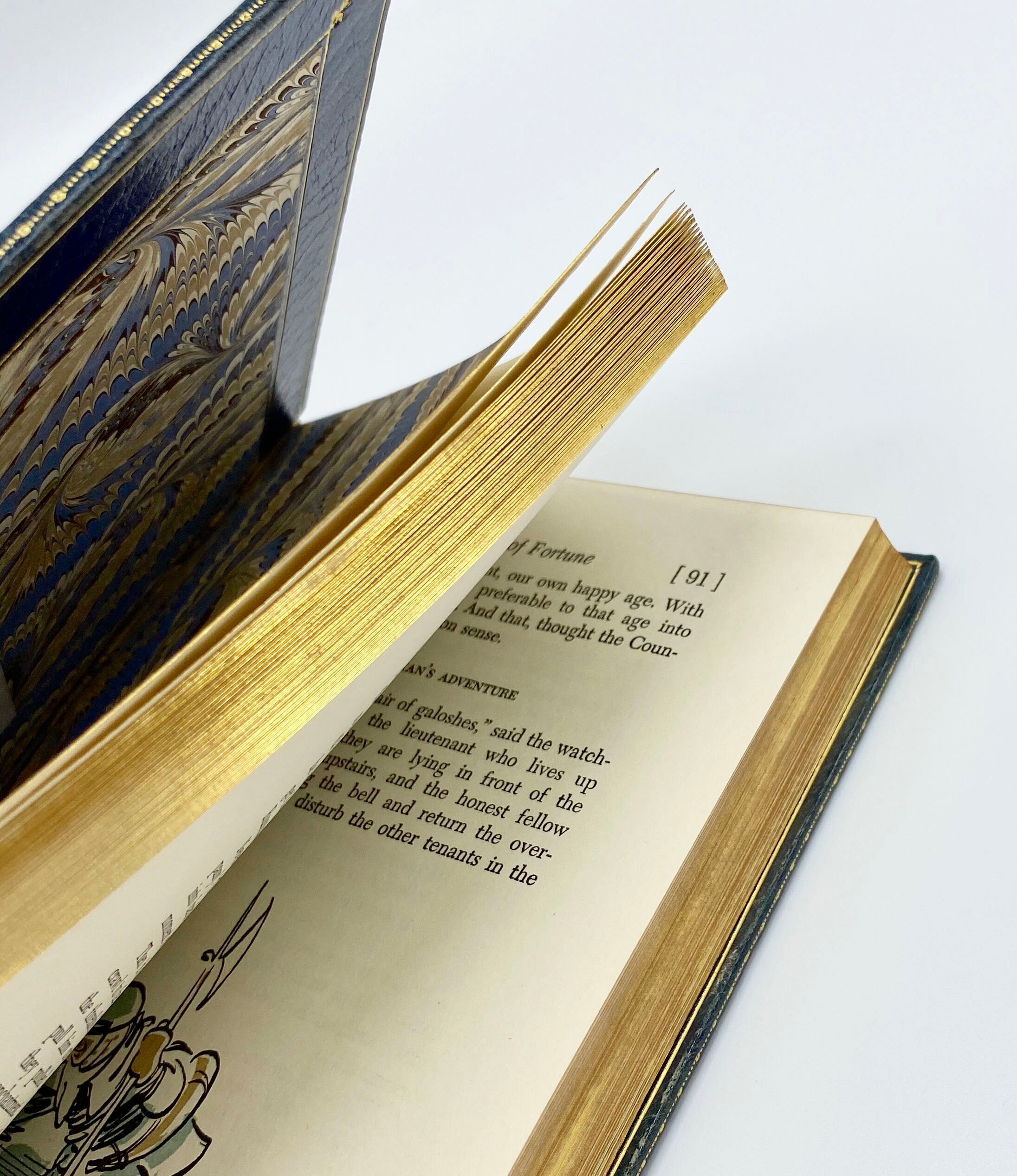
Storing and Handling
Rare Books at Home
If you’re interested in book collecting, you’re naturally concerned about taking proper care of your books.
The following guidelines offer an overview on storing and handling rare books for your personal collection.
Storage
Safely storing your books falls under the topic as “preservation” (rather than “conservation,” which often refers to repairs).
Light
Store your books out of direct sunlight.
Extensive exposure to sunlight damages book bindings just as it does your skin.
The spines on these bindings were once entirely emerald green, just like the strip of leather visible on the left-hand side of the front board. Exposure to sunlight faded them to brown.
Use light sources without damaging UV rays, like LEDs, rather than florescent lights.
In extreme cases — as in iconic dust jackets like on The Sound and the Fury — the damage of UV rays can dramatically affect the market price of that copy. The faded red you see on this spine can potentially knock off thousands of dollars from the price.
Note that the clear archival plastic placed on dust jackets by professional book dealers is not UV resistant. It is meant to protect the jacket while handling only.
Temperature & Humidity
Keep the room temperature as stable as possible.
Fluctuations in temperature are hard on books. 60-70 degrees Fahrenheit year-round is the best balance that stabilizes the books while still being comfortable for you. (Institutions may choose a slightly lower temperature for their storage, meant to last centuries — but that’s without the expectation that humans live there.)
Humidity follows the Goldilocks principle: not too dry, not too wet. Ideally, that will be around 45%. Keep a consistent eye on your shelves if you live in a particularly arid, wet, or humid area.
The worst rooms to store your books are the attic, basement, or garage.
Shelving
The bookcase in your living room, bedroom, or library is the best place to store books in your home: a room where you often spend time.
If you’re following the rules of light and temperature above, such rooms are often the most logical places of storage in a private residence.
Most books can be placed vertically on your shelves. Just keep an eye on your shelves for books tilted at an angle: they should be straight up and down to avoid strain on the joints.
One potential exception: very heavy or tall books may be better stored horizontally on the shelf.
Boxes & Other Forms of Storage
Many more expensive or fragile rare books have a clamshell box custom made for them by a bookbinder. However, as custom professional work, they can be expensive.
If the cost of a clamshell box is prohibitive, a basic archival storage box like this one can be useful for your more fragile or expensive items. Companies like Gaylord and Talas specialize in such archival storage solutions.
Dust your shelves.
Use a feather duster — no chemicals — and dust with a motion away from the spine.
Luxury and practicality: many deluxe antiquarian books are gilt on the top edge. Besides creating an aura of luxury, the gilt top edge of books also serves a practical purpose. It forms a barrier against dust.
Avoid home treatments.
Consult a professional conservator before attempting any repairs or applying foreign agents for cleaning. Dry leather bindings should not be treated without the proper expertise: most bindings do not need oil or other treatments at all. Similarly, household tape for paper tears or hinge strengthening does more damage than good.
Repairs require archival materials and methods best left to the professionals.
Consult a conservator for any complex condition issues: your local university library special collections can likely connect you with a professional.
Handling
First, let’s get the white glove myth out of the way.
Professionals don’t wear white gloves. They lead to more damage than protection. Instead, follow the established practice of washing your hands with soap, then completely drying them, before handling rare books.
Books are engineered to be handled.
The design of the codex format is meant for human hands. You can safely handle the vast majority of books if you follow two main rules.
Rule 1: Avoid pulling a book off the shelf by the head of the spine.
The part of a book that is visible when it is on a shelf next to other books is called the spine. The top of the spine is called the head. The head is one of the weak points of the Western codex format. It can flake or break off if consistently used to pull the book down. Instead, use one of two methods:
Method 1 (preferred): Grasp the book from around its center, with fingers on one side and thumb on the other.
Books should be shelved with enough “give” between them that it is easy to push the book’s neighbors slightly back in order to grasp it in this manner.
Method 2: Pull the book down from the very back, keeping your finger against the bulk of paper that makes up the inside, the “text block.”
This is best when books are shelved too tightly to easily push volumes alongside it back enough to grasp a book by its middle.
Rule 2: Avoid placing stress on the joints of a book.
The joints of a book are where the spine meets the front and back covers (called “boards” for hardcovers and “wrappers” for softcovers). In opening the book, the point where it pivots is the joint.
Many rare books should not be opened at more than a 90 degree angle (and even less for some books). The key is to pay attention: you can often feel the tension when you’ve begun to open the book too wide.
If you’re following these two rules,
you can safely handle the vast majority of rare books.
Recommended method: Open books on a flat surface.
Set the book on a table and use your left hand to hold up the front board at a safe angle. As you look through the book, simply use your right hand to gather more of the leaves into your left hand.
For quick reference, you can hold a book in your hand, if done with proper care. Keep the palm of your hand set against the spine, your thumb laid against one board, and your fingers against the other board. That way, when you open the book, either your fingers or your thumb are supporting the boards and controlling the angle of the joints.
Questions? Ask the rare book dealer.
If you have questions about the storage or handling of a particular rare book offered for sale, ask the seller at the time of purchase.












